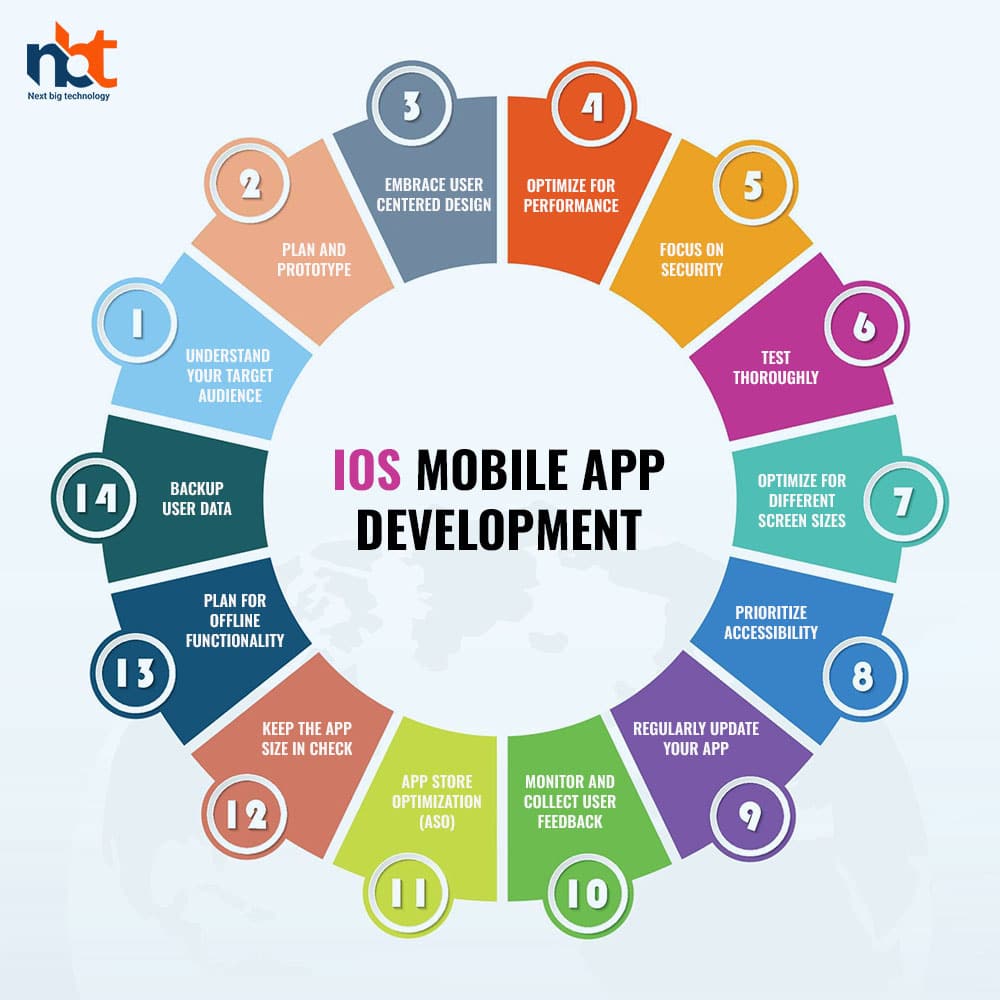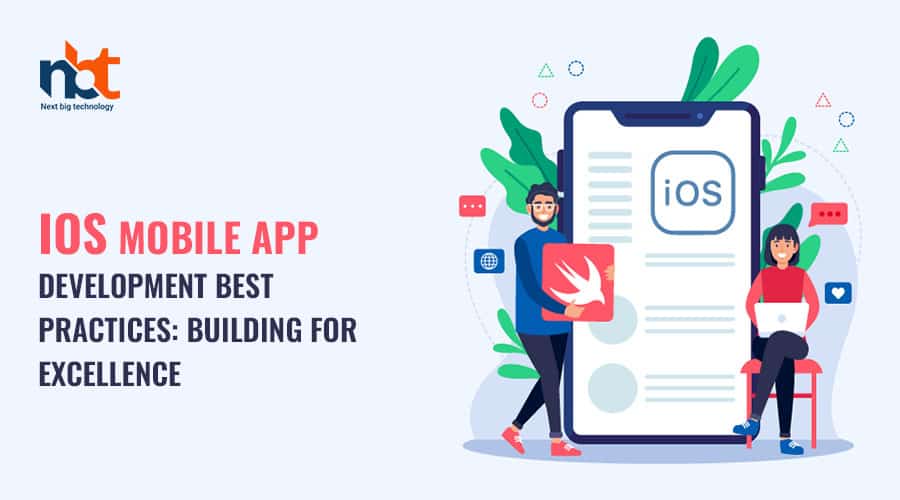In today’s mobile-driven world, developing an iOS app that stands out from the crowd and delivers an exceptional user experience is paramount. iOS mobile app development is a dynamic field that requires developers to adhere to best practices to create successful and user-friendly applications. In this blog post, we’ll explore some of the key best practices that can help you build top-notch iOS apps.
Table of Contents
1. Understand Your Target Audience
Before you start coding, it’s essential to have a clear understanding of your target audience. Research their needs, preferences, and pain points. This knowledge will guide your app’s design, functionality, and user interface.
2. Plan and Prototype
Every successful iOS app begins with a well-thought-out plan and a prototype. Create wireframes and mockups to visualize your app’s layout and flow. This step helps identify potential issues early in the development process.
3. Embrace User-Centered Design
Apple’s Human Interface Guidelines (HIG) are your best friend when it comes to iOS app design. Adhering to these guidelines ensures consistency and a familiar user experience. Prioritize intuitive navigation, responsive interfaces, and user-friendly gestures.
4. Optimize for Performance
iOS users expect apps to be fast and responsive. Optimize your app’s performance by reducing unnecessary animations, using lazy loading for data, and caching where appropriate. Profile and analyze your app to identify bottlenecks and memory leaks.
5. Focus on Security
Security is paramount when handling user data. Follow Apple’s security guidelines, use encryption for sensitive data, and implement secure authentication methods like Touch ID or Face ID. Regularly update your app to patch any security vulnerabilities.
6. Test Thoroughly
Testing is a critical phase of iOS app development. Conduct rigorous testing on various iOS devices and screen sizes to ensure your app functions flawlessly. Consider automated testing frameworks for efficiency.
7. Optimize for Different Screen Sizes
iOS devices come in various screen sizes, so your app must be responsive. Use Auto Layout and Adaptive UI design principles to ensure your app looks and works well on all devices, from iPhones to iPads.
8. Prioritize Accessibility
Make your app accessible to all users, including those with disabilities. Implement VoiceOver, Dynamic Type, and other accessibility features to provide an inclusive experience. Regularly check your app’s accessibility using Apple’s Accessibility Inspector.
9. Regularly Update Your App
Keep your app up-to-date with the latest iOS versions and device changes. This demonstrates your commitment to delivering a seamless experience and ensures compatibility with new features.
10. Monitor and Collect User Feedback
Once your app is live, monitor its performance and collect user feedback. Pay attention to app store reviews and ratings, and consider using analytics tools to track user behavior. Use this data to make informed updates and improvements.
11. App Store Optimization (ASO)
To increase your app’s discoverability, invest in App Store Optimization. Optimize your app’s title, description, keywords, and visuals. Encourage users to leave positive reviews and ratings.
12. Keep the App Size in Check
Large app sizes can deter users from downloading or updating your app. Minimize unnecessary assets and use app thinning techniques to reduce the overall size.

13. Plan for Offline Functionality
Design your app to work offline when possible. Users appreciate apps that can still provide core functionality even without an internet connection.
14. Backup User Data
Implement a reliable backup and restore mechanism to safeguard users’ data. iCloud integration can be beneficial for this purpose.
In conclusion, iOS mobile app development best practices are crucial for creating apps that resonate with users, perform well, and stand the test of time. By following these guidelines, you can set your app on the path to success in the competitive iOS app market. Remember that excellence in app development is an ongoing journey of learning and improvement.
FAQ
1. What are iOS Human Interface Guidelines (HIG), and why are they important?
iOS HIG are design principles provided by Apple to ensure a consistent and user-friendly experience across iOS apps. They are crucial because they help maintain a cohesive look and feel, making your app more intuitive to users.
2. How can I optimize my iOS app’s performance?
Performance optimization can be achieved by minimizing animations, using lazy loading, and profiling your app to identify and address bottlenecks. Regular testing on different devices is also essential.
3. What are the best security practices for iOS app development?
Security is vital. Utilize encryption for sensitive data, implement secure authentication methods (e.g., Touch ID, Face ID), and stay updated on security guidelines from Apple. Regularly update your app to fix any security vulnerabilities.
4. How do I ensure my iOS app works on different screen sizes and devices?
Use Auto Layout and Adaptive UI design principles to create responsive interfaces that adapt to various screen sizes, including iPhones and iPads.
5. What should I consider for accessibility in my iOS app?
Prioritize accessibility by implementing features like VoiceOver and Dynamic Type. Regularly check your app’s accessibility using Apple’s Accessibility Inspector to ensure it’s inclusive for all users.
6. How often should I update my iOS app?
Regular updates are important for compatibility with new iOS versions and devices. It’s recommended to update your app at least once every few months to add new features, fix bugs, and improve performance.
7. What is App Store Optimization (ASO), and why is it important?
ASO involves optimizing your app’s listing in the App Store by improving its title, description, keywords, and visuals. It’s essential for increasing your app’s discoverability and attracting more users.
8. How can I minimize my iOS app’s file size?
Reduce unnecessary assets, use app thinning techniques provided by Apple, and consider compressing images and videos to minimize the overall app size.
9. What should I do to ensure my iOS app works offline?
Plan for offline functionality by caching data and providing appropriate user feedback. Ensure that essential features can still be used without an internet connection.
10. How do I backup user data in my iOS app?
Implement a reliable backup and restore mechanism, and consider using iCloud integration to securely store and synchronize user data.
These FAQs cover some of the fundamental aspects of iOS mobile app development best practices. Implementing these practices will help you create successful and user-friendly iOS apps that meet the highest standards of quality and performance.
IOS App Development Process
The iOS app development process involves several steps, from ideation to app deployment. Here’s a detailed overview of the iOS app development process:
1. Idea Generation and Conceptualization:
The process begins with brainstorming and generating app ideas. Consider user needs, market trends, and your own passions and expertise. Define a clear and unique app concept.
2. Market Research and Competitive Analysis:
Research the target market to identify competitors, user preferences, and potential opportunities. This information will help refine your app concept and strategy.
3. Define App Requirements:
Create a detailed list of functional and non-functional requirements for your app. This includes features, user interactions, platform compatibility, and performance expectations.
4. Wireframing and Prototyping:
Create wireframes and prototypes to visualize the app’s layout, user interface, and user experience (UI/UX). These visual representations help in refining the app’s design.
5. Design and UI/UX Development:
Based on wireframes, design the app’s user interface and user experience. Focus on creating an intuitive and visually appealing design that aligns with iOS Human Interface Guidelines (HIG).
6. App Architecture and Technology Stack Selection:
Choose the appropriate architecture and technology stack for your app. Decide whether you’ll develop a native iOS app using Swift or Objective-C or opt for cross-platform development tools like React Native or Flutter.
7. Development:
Start coding the app according to the defined requirements and design. Implement core functionality, integrate APIs and databases, and handle user data securely.
8. Testing:
Rigorously test the app for functionality, usability, and performance. Conduct various types of testing, including unit testing, integration testing, and user acceptance testing.
9. Debugging and Optimization:
Identify and fix any bugs or issues that arise during testing. Optimize the app’s performance, memory usage, and battery efficiency.
10. Quality Assurance (QA):
Conduct thorough QA testing to ensure the app meets quality standards and is free of critical bugs or usability issues.
11. User Interface (UI) Polish:
Refine the app’s UI based on user feedback and testing results. Ensure a seamless and intuitive user experience.
12. Beta Testing:
Release a beta version of the app to a limited group of users or testers to gather feedback and make final adjustments.
13. Legal and Compliance Considerations:
Address legal aspects such as privacy policies, terms of service, and compliance with Apple’s App Store guidelines and regulations.
14. App Store Submission:
Prepare all necessary assets (app icon, screenshots, descriptions) and submit the app to the Apple App Store for review. Comply with Apple’s guidelines and requirements.
15. Marketing and Promotion:
Develop a marketing strategy to promote your app. Utilize various channels such as social media, app reviews, and paid advertising to increase visibility.
16. App Deployment:
Once your app is approved by Apple, it can be published on the App Store for users to download and install.
17. Post-Launch Support and Maintenance:
Continue to monitor and maintain the app post-launch. Address user feedback, fix bugs, release updates, and add new features as needed.
18. User Engagement and Feedback:
Encourage user engagement and gather feedback to improve the app’s functionality and user experience over time.
19. Analytics and Performance Monitoring:
Utilize analytics tools to track user behavior, app performance, and user engagement metrics. Use these insights to make data-driven decisions for future updates.
20. Continuous Improvement:
The iOS app development process is ongoing. Regularly assess the app’s performance, user feedback, and market trends to plan and implement improvements and updates.
By following this comprehensive iOS app development process, you can create a successful and user-friendly app that meets the needs of your target audience while adhering to Apple’s guidelines and best practices.
Thanks for reading our post “iOS Mobile App Development Best Practices: Building for Excellence”. Please connect with us to know more about IOS App Development.

















